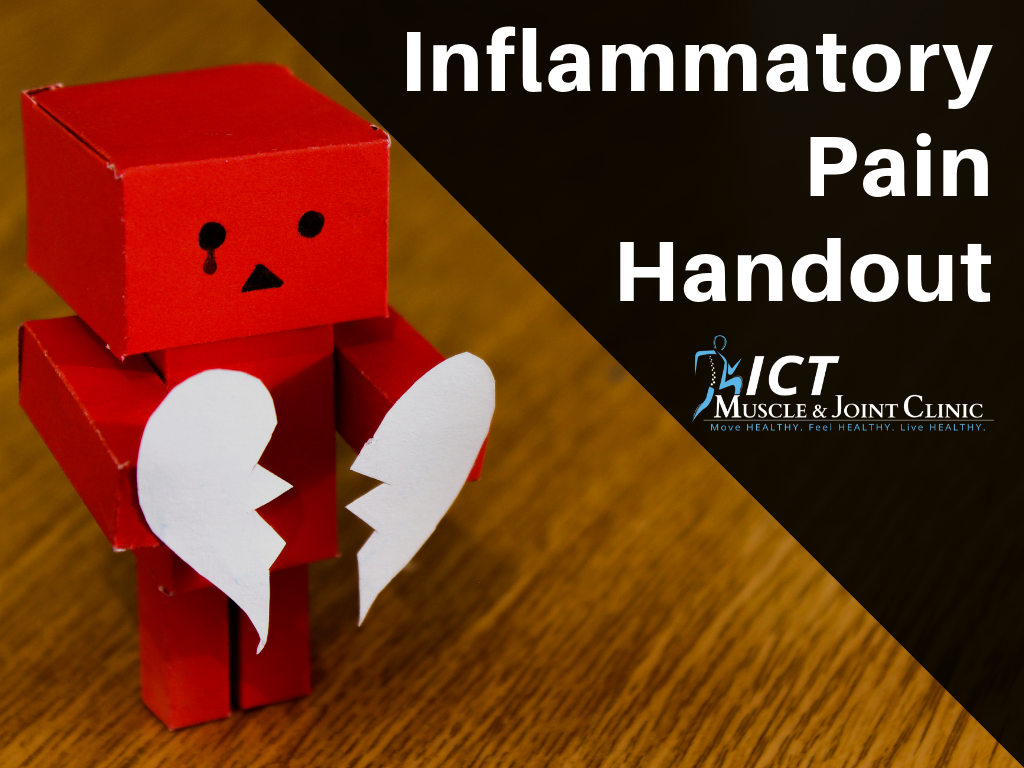Inflammatory Pain Handout
WHAT IS INFLAMMATION?
After an injury, or flare-up of an existing issue, the body produces inflammation. Symptoms of inflammation may include: pain, swelling, redness, increased temperature, and loss of movement. When inflammation sets in, it usually is felt as an increase in 3 points on a 10-point scale, which lasts longer than a day. Once inflammation sets in, the body starts to heal. Pain is your body’s response to inflammation. Pain bring awareness to an area of the body to decrease the odds of re-injury during the early phase of healing.
WHAT ARE CAUSES OF INFLAMMATION?
Anything that causes tissue damage or strain can cause inflammation.
Examples: sprain/strain, leaky gut (food sensitivities), working out.
WHAT DOES INFLAMMATION FEEL LIKE?
Inflammatory pain may be described as:
- “I feel stiff or tight”
- “I have pain here when I move like this”
- “I hear and feel crackling”
- “I have a constant dull ache that doesn’t ever go away”
- “I have a nagging issue in multiple areas of my body that never get better”
WHAT CAN YOU DO?
It is important to categorize your type of inflammatory pain. Typically, there are two types of inflammatory pain after an injury. A third type of inflammatory pain can be present at the same time for other reasons (systemic inflammation). Understanding the difference can help guide you toward the right intervention.
Mechanical Inflammatory Pain
Mechanical pain gets better and worse depending on the position of your body or movement(s) that you perform. With mechanical inflammatory pain, if there is a position or movement that hurts, then the opposite position or movement might be therapeutic. Over-the-counter pain medication may or may not be helpful here. It may take the edge off the pain but not reduce it significantly. Healthcare providers who may be able to help direct care during this type of pain include: chiropractors, physical therapists, and massage therapists.
Chemical Inflammatory Pain
Chemical pain gets worse with all positions and movements. With this type of pain, rest, anti-inflammatory foods, spices and medications are beneficial. These “supplements” work by reducing chemical pain receptors in the body. Typically, after the first 5-7 days of a flare up or new injury, chemical inflammation is gone. Healthcare providers who may be able to help direct care during this type of pain include: a family M.D., a chiropractor, and a naturopath.
About the author
Dr. Keith Sparks is an award-winning chiropractor, functional medicine expert, and the co-founder of ICT Muscle & Joint Clinic. Dr. Sparks’ emphasis of care originated within the fields of rehabilitation, soft-tissue therapies, and chiropractic. To date, he has brought this unique combination of skills into union with functional medicine. The sole purpose of intertwining these distinct skills, knowledge, and services is to provide incomparable care to his local community. Dr. Keith Sparks is often seen in the Wichita, KS community speaking at business events and teaching health and performance classes.
